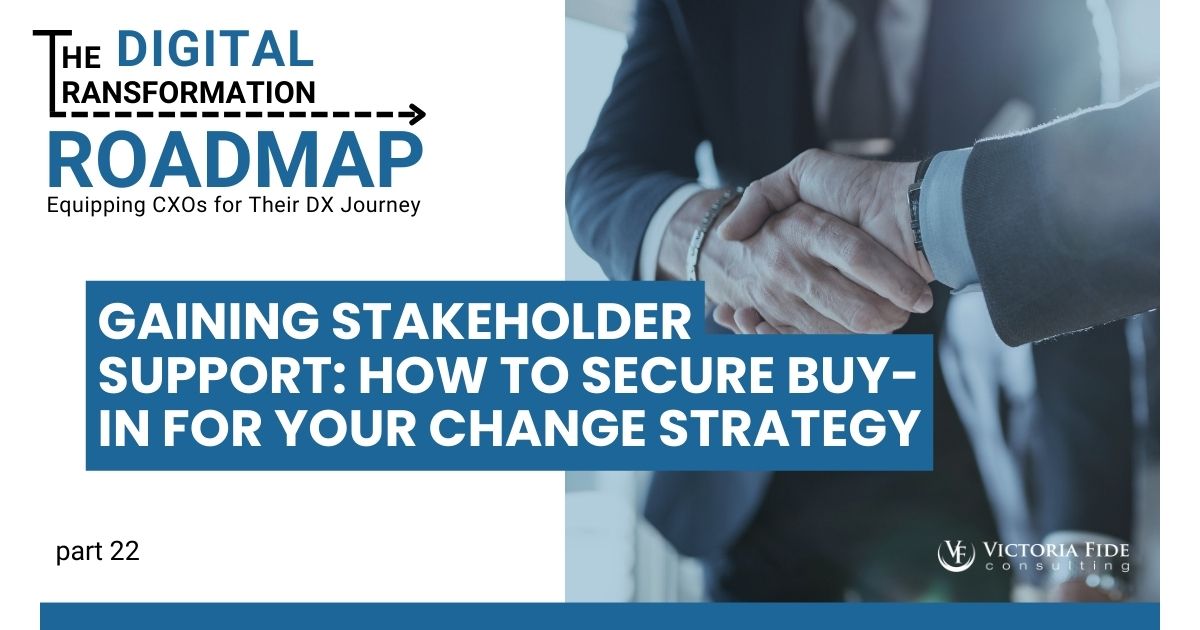
Gaining Stakeholder Support: How To Secure Buy-In for Your Change Strategy
The DX Roadmap series is produced by Victoria Fide Marketing with input and oversight from our leadership team and industry SMEs.
Table of Contents
Numerous studies have shown that close to 70% of digital transformation (DX) projects fail, which begs the question, why? The past decade has seen a meteoric rise in the awareness and formalization of change management as a significant factor in project success. In fact, according to a 2023 study by Prosci, projects with excellent change management are up to seven times more likely to meet their objectives.
However, despite the increase in general acceptance around the importance of change management, Organizational Change Management (OCM) consultants and other change leaders continue to face resistance when attempting to gain buy-in for a comprehensive change management program within their DX project. This is why delivering the Organizational Change Strategy to project sponsors, steering committee members, and other key stakeholders can be just as important as building the change strategy itself.
Delivering the strategy is much more than simply presenting the report; it requires helping the stakeholders digest the information being presented, educating them on the importance of change management and the impact of each activity on their organization, and securing buy-in to increase project success. This article will provide considerations and strategies for communicating your change strategy to relevant stakeholders in a way that will facilitate collaborative discussions, mitigate known risks, and increase buy-in for your organizational change strategy.
Effectively Communicating Your Change Strategy to Stakeholders
In part 18 of The Digital Transformation Roadmap series, we explained how to create a Change Management Strategy customized to your organization’s specific needs. This change strategy takes the results from your Organizational Risk Assessment and combines it with standardized OCM best practices and project-specifics such as complexity, history of engagement, and organizational culture to build a customized change management approach.
When delivering the change strategy to stakeholders, there are three main objectives to keep in mind:
1. Define a Clear Vision of Project Success for Change Management
Many people may have different opinions or perspectives of what “success” looks like based on their own past experiences with DX initiatives. It’s crucial to establish a shared vision for what project success looks like, so everyone can align on what is required to achieve that desired outcome. Project success starts with understanding the business objectives outlined in the project charter, but it encompasses so much more, including:
- User adoption
- Receiving meaningful feedback throughout the journey
- Prioritizing continuous improvement
- Having engaged stakeholders who champion the product
Project success goes beyond completing an implementation on time and within budget; it’s about empowering change agents to influence the culture for the better. A successful project ensures the journey is fruitful and will have a lasting impact well beyond the initiative itself.
2. Correlate Change Management Strategies with Project Success
Once everyone agrees on the definition of project success, it’s time to illustrate how change management strategies can directly influence project outcomes. Showcasing research and statistics from reliable sources like Prosci or Gartner can help illustrate the importance of change management in project success. Highlighting specific examples from previous initiatives can help drive home the point that without proper change management, the chances of meeting project objectives decrease significantly.
3. Secure Buy-In for Change Strategy Recommendations
After everyone is aligned on the definition of project success and the role of change management in achieving it, it’s time to deliver the change strategy. Beyond simply outlining the recommended level of involvement for the activities in the change strategy, it crucial to address the “WIIFM” or, “What’s in it for me?” Change is personal, and a one-size-fits-all approach won’t be effective. It’s important to know what will resonate with a particular team or key individual, and ensure they have the necessary buy-in to be an effective change agent.
Given the high stakes and nuanced strategy for securing buy-in for such an integral piece of the project’s success, delivering the change strategy is generally performed by an experienced OCM consultant – whether from an internal department or an external resource like Victoria Fide – but can also be completed by other project leader roles.

Transformation is not easy, but it doesn’t have to be impossible. Take control of your project’s success today and schedule a free 30-minute consultation to find out how Victoria Fide can equip you for transformational success.
Overcoming Barriers: Strategies to Mitigate OCM Resistance
Depending on the makeup of the team, the complexity of the change strategy, and the atmosphere best suited to allow leaders to digest complex information, the two-fold objective above may be accomplished within a single meeting or may require a series of meetings. It is best to provide the proposed change strategy in advance to allow ample time for the members to review, absorb the information, and formulate questions.
During the meeting(s), it’s crucial to maintain an open, two-way avenue for communication. It is this collaborative approach that leverages both the OCM consultant’s knowledge of change management best practices and the context and clarity of the business objectives from the project sponsor and other stakeholders. This opportunity for discussion is especially important if some of the change management strategy involves information that may come as a surprise to the stakeholders.
Often, executives or high-level leaders within the organization can have blind spots when it comes to the reality “on the ground” within the project teams. Their perception of their team’s makeup, abilities, and strengths may be skewed, and some findings from the risk assessment and the recommendations provided within the change strategy may be difficult to swallow. This is why delivering the change strategy requires expertise, nuance, and a strategic approach including showing examples, providing data, and welcoming feedback.
While it may not be possible to secure 100% buy-in at this stage, it can be a huge step in the right direction. It is important to capture and document all feedback and differences in opinions that arise during these meetings. Make sure to track areas of high interest or risk and commit to ongoing check-ins as the project progresses.
Engaging Stakeholders in the Risk Mitigation Process
Risk mitigation in digital transformation projects is an ongoing process of identifying, removing, and reassessing barriers that arise. During the meetings to deliver the proposed change strategy, discuss how to overcome existing barriers while planning mitigation for any future risks in identified areas. Documenting these discussions, proposed mitigation strategies, and follow-up actions enables the team to proactively tackle potential obstacles and maintain a clear, strategic plan. This includes aspects such as training, communication, resources, or the most effective ways to engage and collaborate with certain teams.
For example, throughout several stakeholder interviews at one organization, it became apparent that the Purchasing team was difficult to work with and didn’t adapt well to change. The OCM consultant proposed to the Project Sponsor that they take proactive steps to establish an ongoing touchpoint with the Purchasing Team Director to hear and address any concerns. Knowing this was an area of resistance helped the Project Sponsor adjust expectations, allocate their time appropriately, and use their influence and pre-existing relationship to mitigate the resistance.
Overall, risk mitigation is an ongoing process that requires constant attention and communication. It involves identifying potential barriers, creating plans to overcome them, and continuously reassessing the effectiveness of those plans. By maintaining open communication and actively addressing any potential risks through a customized organizational change management strategy, DX projects can have a higher chance of success.

Overcoming Resistance: Delivering A Change Strategy to Secure Project Success
Statistics consistently demonstrate that effective change management significantly enhances a project’s ability to meet its objectives, stay on schedule, and remain within budget. More than just presenting recommended OCM activities, the process of delivering the change strategy involves guiding the project sponsor and stakeholders through the information within the report and ensuring they grasp the importance of all the proposed change management activities. Gaining their buy-in is crucial for the success of the upcoming project and risk mitigation activities.
Furthermore, providing space for discussion around identified risks or barriers combines the OCM lead’s expertise in change management best practices with the project-specific insights and influence from the project sponsor and other stakeholders. This collaborative approach drives data-informed strategies for minimizing risk and empowering teams and individuals for a successful transformation.
After securing buy-in on the change strategy, the OCM lead will begin building out the detailed Organizational Change Management Plan and executing on the specific activities outlined in the change strategy. By ensuring thorough documentation and proactive OCM engagement, you can set the groundwork for a streamlined and successful digital transformation.
Ready to elevate your digital transformation initiatives? Subscribe to our LinkedIn newsletter for an inside look at how Victoria Fide’s Process for Transformational Change is ensuring success for companies embarking on a DX journey. Each week, you’ll get a breakdown of a crucial step in the journey, tailored for CXOs and project leaders. Gain the insights and strategies needed to excel in your self-directed DX efforts. Don’t miss out—subscribe now and stay ahead of the curve!
Subscribe to our weekly LinkedIn Digital Transformation Success newsletter and get notified of each new edition.
